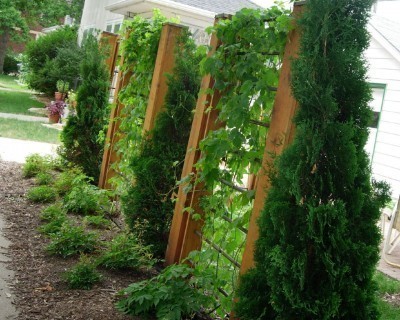
Use your drawing and notes to determine low-maintenance solutions for these trouble spots. For instance, consider implementing a trellis for an attractive, low-maintenance flowering vine to climb along for help in concealing that unsightly area. Consider using a nice-looking, easy-care ground cover for that steep, hard-to-mow slope. Visualize what you want and make it happen.
The design of your low-maintenance landscape determines its ultimate upkeep. It’s always better to start small, especially if you’re a first timer. Consider the amount of time you want to spend on maintenance, especially when it comes to tasks you’d rather not perform. For instance, if you don’t enjoy mowing, enlarge existing garden areas (or create some) to reduce lawn areas. Fill in these garden beds with low-maintenance plants.
Mulch is always welcome in the low-maintenance landscape. Mulch beds to reduce weeding and water maintenance as well as to make them more appealing. Also, add attractive edging between beds and lawn areas. Edging keeps mulch in and lawn out.
Think about hardscape features such as patios, walks, and decks. These can also reduce lawn areas and maintenance chores. Make sure, however, to keep these compatible to the surroundings. If the landscape and hardscape features do not complement one another, the entire design will look out of sorts and unattractive.
Low-Maintenance Plants
The most important aspect in a low-maintenance landscape is, of course, the plants.
- Ground cover – Nothing speaks low maintenance better than ground covers, as most require little care. Ground covers are a great way to add variety, texture, and color to the low-maintenance landscape. They work well on slopes, reducing erosion as well as maintenance. They can also replace the lawn for those choosing to cut out the need for mowing. Clumping ground covers also make excellent edging for beds and borders.
- Meadows or prairies – Another way to reduce the size of your lawn is by implementing a wildflower meadow, or prairie garden, which can look great in an open backyard. This type of garden is easy to create and only requires mowing once or twice a year, especially during late summer or early fall to help spread seed for the following season. A low-maintenance meadow not only looks attractive, but it also attracts wildlife such as birds, butterflies, and beneficial insects.
- Drought tolerant plants – Drought-tolerant plants are always a plus as they require little watering. When choosing any plant, look for those that thrive within your region and place plants sharing similar needs together. For instance, different plants have different needs. Some require full sun, other prefer shade. Some tolerate hot, arid conditions, while others enjoy cool, wet locations. Choosing the right one for the right spot reduces maintenance.
- Containers and vegetables – High-maintenance plants, such as container or vegetable plantings, usually require a lot of time and attention; therefore, these should be used sparingly and only within areas that have the most impact, such as entrances for containers, or close to water sources, such as with vegetables.
- Trees and shrubs – This same concept applies to trees and shrubs as well. Not only should you select those adapted to your area but also those that require little upkeep. Remember to consider their growth characteristics and mature height. If, on the other hand, you already have existing high-maintenance trees or shrubs, consider their overall importance within the landscape and determine whether they should be removed and replaced with alternatives that are more carefree.
Having a low-maintenance landscape not only allows you to garden with ease, but it also allows more time to sit and relax while taking in all the beauty that nature has to offer.






